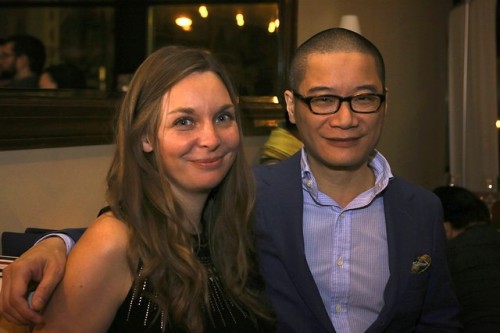Let’s put politics aside for a few days this October to enjoy one of the world’s most fascinating wines: sherry. If you’ve not caught the sherry bug yet, Sherryfest returns to NYC on October 27-29, 2017, with a slew of opportunities to help you do so. From educational tastings, to dinners, to a Sunday brunch (it’s time we swap those diluted mimosas for food-friendly Fino), there’s something for everyone.
In a recent interview originally posted on Forbes, Sherryfest co-founder Rosemary Gray speaks to her love for the wine, her reason for creating the event, and her favorite sherry with oysters.
Why did you create Sherryfest?
Sherry has long been a misunderstood wine category – both within the industry and by consumers. We wanted to give people an opportunity to learn about sherry, celebrate it, and meet the amazing bodegas (wineries) and people of the region. Many people don’t know that sherry is one of the world’s most historically important wines , and while the region is enjoying a bit of renaissance, it’s also struggling and needs support. Our hope is the Sherryfest events will help sherry become increasingly valued by wine connoisseurs and casual drinkers. If people have the opportunity to taste for themselves how intricate, nuanced and multi-faceted sherry is, then we hope they will reach for sherry more frequently just as they would other wines, cocktails, or beverages. Sherry umbrellas an incredibly diverse family of wines, so we created events that would make it easy to learn about and taste that diversity. Many sherries are ideal companions at the table, can age in the cellar, can be ideal as part of a cocktail, or enjoyed as a stand-alone beverage – we want to give people opportunities to experience all of that.
How long has the festival been running?
I co-founded Sherryfest with author Peter Liem (Sherry, Manzanilla & Montilla) along with the support of the Consejo Regulador of the sherry region (the governing body of the D.O.C.) in order to spread awareness of and celebrate the wine. The first Sherryfest was fall of 2012 in New York City. In 2013, we held three Sherryfests – one in Portland, Oregon in the spring, and then back-to-back events in the fall in New York City and Toronto, Canada. In 2014, we held Sherryfest in San Francisco, CA, in 2015 we returned to New York, in 2016 Sherryfest was held in Chicago, and we will again return to New York in October 2017. So, it will be eight Sherryfests in five years.
How has Sherryfest changed since the first year? What’s new this year?
The first year was big – we held something like eight dinner events over the course of a week. We’ve learned it’s best to keep the span of events compact over a couple days, and to offer a variety of activities – dinners, seminars, happy hours, parties all centered around the centerpiece Grand Tasting (a walk-around tasting of over 150 sherries). This year we’ve moved events to the weekend in order to accommodate and welcome more consumers, as well as industry and media professionals. Each year we try something new – this is the first year we are hosting a brunch. It will be the final event of Sherryfest – a Sunday afternoon collector’s lunch for people to share their favorite sherries and socialize with producers and other sherry-lovers.
What have you learned over the last few years of hosting Sherryfest?
I’ve learned a lot about sherry! That sounds obvious, but the truth is when we create spaces for others to learn we learn ourselves. My appreciation and enthusiasm for sherry has grown deeply. Not just with regards to knowledge and understanding of the wines, but also the people, culture and the heart of the region. That connection is a profound reminder that wine is not just a market trend or a consumer good – it’s a special transmitter of stories, and in the case of sherry that story is rooted in a place and that is rich in history, characters, heart and valor.
How has the consumer’s attitude towards sherry changed?
People are more exposed to the spectrum of sherry now. Instead of just thinking of Cream sherry (one of many types), people are now aware there are dry styles like Fino and Oloroso, as well as the sweet styles. People are familiar with sherry as a cocktail ingredient, and we are even beginning to see wine connoisseurs collecting fine and rare sherries. What we still want to see more of is people enjoying sherry with a meal, because sherry is one of the most versatile food wines. It’s one of the reasons we always have dinner (and now brunch!) events – to give people an opportunity to see the brilliance of sherry at the table.
How has the industry’s attitude towards sherry changed?
The industry has become more knowledgeable. It’s less often that we see dry sherries placed under the dessert section of a wine list for instance. Professionals treat sherry for what it is – a fine wine with many great producers. Industry professionals are now seeking out the great producers and special bottlings and showcasing them in their restaurant and retail wine programs. Also, the bar and cocktail community has really lead the renaissance by incorporating sherry in cocktail programs, and this really increases people’s exposure to the many styles of sherry.
What’s your favorite style of sherry to drink and why?
There sheer diversity of sherry makes it hard to pick a favorite! I love Fino and Manzanilla as an aperitif – the saline, savory tones are thrilling with things like oysters and fried foods. I love sipping on Oloroso or a nuanced Palo Cortado just as I would a spirit like Bourbon or brandy. Amontillado is wonderful with savory foods – it’s a brilliant dinner companion with fall dishes like roast chicken. Also, sushi and Japanese-influenced foods are wonderful with sherry – the umami against umami creates great chemistry. I also love cream sherry as an after-dinner treat – it’s my way of “sipping dessert,” as it’s just lightly sweet and still bright and nuanced.
What upcoming Sherryfest events are you excited about?
I’m especially excited for this year’s dinner and brunch events. I love getting people around the table to experience how wonderful sherry is with food. These events are so fun and convivial; I love giving guests an opportunity to engage with producers, while having a unique and rare food and wine experience with their friends. Here are a few events I’d recommend: the Toro Dinner, the Rouge Tomate Dinner, and the North End Grill Brunch.
Anything else you want to add?
Sherryfest is true labor of love. Peter and I are just two passionate industry professionals that started this because we love sherry, and wanted to create space for others to celebrate and appreciate the wines too. We have great supporting partners, but Sherryfest isn’t really a marketing or sales event – it’s an educational and social experience that is a way for us to bring the beauty of Jerez stateside. Sherry is such a historic and complex wine that is often underappreciated, and every year we feel so fortunate to be able to spread the joy of sherry.
















